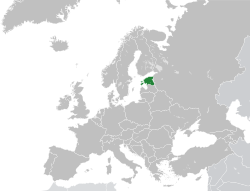Estonian Government in Exile
| Estonian government-in-exile | ||||||||||
| Eesti valitsus-in-eksiilis | ||||||||||
| Government-in-exile | ||||||||||
|
||||||||||
|
||||||||||
|
Location of Estonia.
|
||||||||||
| Capital | Tallinn | |||||||||
| Capital-in-exile | New York City | |||||||||
| Government | Transitional government | |||||||||
| Prime Minister in duties of the President/Acting Prime Minister | ||||||||||
| • | 1940–1945 | Jüri Uluots | ||||||||
| • | 1944–1953 | Otto Tief | ||||||||
| • | 1990–1992 | Enno Penno | ||||||||
| Historical era | Cold War | |||||||||
| • | Established | June 1940 | ||||||||
| • | Estonian Independence | 20 August 1992 | ||||||||
|
||||||||||
The Estonian government-in-exile refers to the formally declared governmental authority of the Republic of Estonia in exile, existing from 1953 until the reestablishment of Estonian sovereignty over Estonian territory in 1992. It traced its legitimacy through constitutional succession to the last Estonian government in power prior to the Soviet invasion of 1940. During its existence, it was the internationally recognized government of Estonia.
The USSR illegally annexed Estonia in June, 1940. Soviet authorities arrested President Konstantin Päts and deported him to the USSR where he died in prison in 1956. Many members of the current and past governments were deported or executed, including eight former heads of state and 38 ministers. Those who survived went underground.
Jüri Uluots was the last constitutional prime minister at the time of Soviet occupation. With the loss of Päts, Uluots, as the head of the Estonian government in accordance with Section 46 the Estonian Constitution (Riigi Teataja 03.09.1937 No. 71 Art 590), which specified that in the case that the President vacated the office or was otherwise unable to execute his duties, those duties were to be assumed by the Prime Minister, who carries duties of the Prime Minister to the Acting Prime Minister, became acting head of State.
Uluots attempted to appoint a new Estonian government in July 1941, at the beginning of the German occupation, but German authorities refused to recognize Estonia as a sovereign state.
The National Committee of the Republic of Estonia was formed from individuals engaged in the Estonian government prior to Soviet annexation. The Committee was led initially, from March 23, 1944, by Kaarel Liidak, then, from August 15 or 16, by Otto Tief. The Committee proclaimed itself the supreme power of the Republic of Estonia on August 1, 1944.
In June 1942 political leaders of Estonia who had survived Soviet repressions held a meeting hidden from the occupying powers in Estonia where the formation of an underground Estonian government and the options for preserving continuity of the republic were discussed. On January 6, 1943, a meeting was held at the Estonian foreign delegation in . In order to preserve the legal continuation of the Republic of Estonia, it was decided that the last constitutional prime minister, Jüri Uluots, had to continue to fulfill his responsibilities as prime minister. On April 20, 1944, the Electoral Committee of the Republic of Estonia (Vabariigi Presidendi Asetäitja Valimiskogu, the institution specified in the Constitution for electing the Acting President of the Republic) held a clandestine meeting in Tallinn. The participants included:
...
Wikipedia



